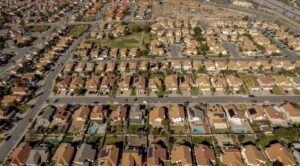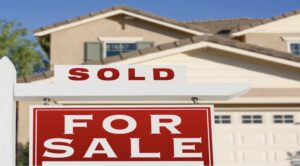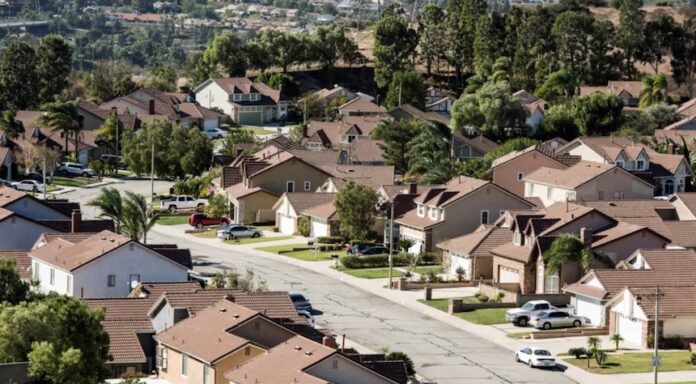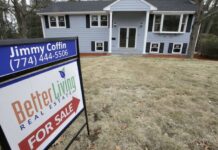A recent Bloomberg report shows that an alarmingly small number of Californians can afford to buy a single-family home. The dream of owning a home and having a family is a distant memory.
California Association of Realtors released a report Friday showing that only 16% of households qualified to buy a single-family house priced at the median price in the second quarter. This is down from 19% during the first quarter and 17% one year ago.
California’s least affordable counties are usually the usual suspects. Mono County is home to Mammoth Lakes and has the lowest affordability in California. Only 5% of its residents can qualify for a mortgage. Santa Barbara (10%) is ranked fifth, followed by San Luis Obispo (11%), Monterey, and Orange County (12%).

Los Angeles County ranked 15th in the index of housing affordability. San Bernardino County, Southern California’s most affordable county, scored a 30% affordability rating.
This isn’t the end of the nightmare. According to the report, in order to buy a single-family median-priced home in California, residents need to have an annual income of $200,000 or more.
In the second quarter, to qualify for a 30-year loan on a single-family house in California with a median price of $830.620, buyers needed a minimum income of $208,000 per year after paying 20%. Condos and townhouses with a median price of $640,000 required a minimum income of $160,400.
The Golden State continues to appear as a place where people cannot live a decent middle-class life. California’s cost of living has risen exponentially in the last seven to ten years. With the passage of SB1 in 2017, also known as the gas tax, consumers across the state are now paying an extra $0.58 for every gallon of gasoline or diesel.

California has historically had higher gas costs than the rest of the country because of state emission standards that require a specific blend of fuel to be used for each season. Californians pay $1.25 more per gallon compared to the rest of America. For each gallon, you’ll also have to pay $1.18 in taxes and fees. California residents also pay higher vehicle registration fees and have to pay higher fuel prices. They are also prohibited from operating any diesel-powered buses or trucks over 14,000 pounds in the state.
The COVID fiasco had already left the nation in a bad state when President Biden assumed office. After just one year, inflation reached its highest level since 1980. The highest rate was 9.1 percent recorded in June 2022. The cost of living remains high despite the fact that inflation rates are decreasing. The United States has the highest credit card debt in history, with Americans accumulating over $1 trillion.
A Reuters/Ipsos survey found that many of those who voted for Biden in 2020 are now dissatisfied with his economic leadership. This has led them to doubt their support for a possible reelection bid for 2024. These sentiments reflect broader concerns over the direction of the country’s economy, as reflected by the president’s consistently lower approval ratings. They now hover at 40%.

The unprecedented rise in credit card debt is a critical part of the economic struggle Americans are experiencing. It has now surpassed a staggering $1 trillion. Consumers are being burdened by the rising costs of goods and services due to a combination of stubborn inflation and high-interest rates. The New York Fed’s Quarterly Report on Home Debt and Credit vividly illustrates this dire situation. It shows that credit card debt has risen by nearly 4.6 percent, with $45 billion added in just the second quarter.
Californians, and the majority of Americans, are living paycheck-to-paycheck. According to a recent report, 61 percent of Americans live paycheck-to-paycheck, and 3.3 million Californians reported the same. It seems we’re in for a tough time as financial uncertainty continues to grow. Costs of goods are still higher than usual, including groceries and all consumable items.
As of July, 61% of American adults reported they are living paycheck to paycheck.
That’s Bidenomics in action.
— Sen. Marsha Blackburn (@MarshaBlackburn) August 31, 2023
California’s state legislator, especially Washington, does not help with the policies. Our residents are suffering because of the push at the federal and state levels to increase green energy products and projects. The push in California to switch to solar energy for all homes and to reduce natural gas and refineries is also driving up utility prices. The green initiative has also pushed an already stressed power grid to levels of reliability that have never been seen before. Shutting down power on windy days has become a common practice.
California, as I have reported in the past, continues to drive out the middle and lower classes. Democrats who rule California with an iron hand claim to be for working people, but they only care about your money.
California is in decline, and Democrats alone are to blame. Californians are paying more for their basic needs, have less money available to spend, and receive less in return from the state. California has lost more than 800,000 people, one electoral vote, and a seat in Congress, and this trend is not expected to stop. If the trend continues – and polls indicate it will – California could lose more than tens or thousands of people. Imagine a failure if that’s the case.
It’s inevitable that something will give. When will the next shoe fall? Anyone’s guess will do at this point.




